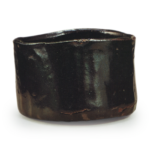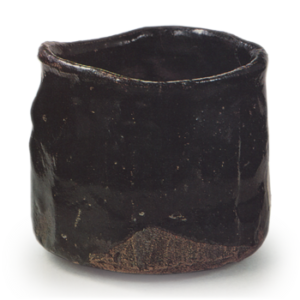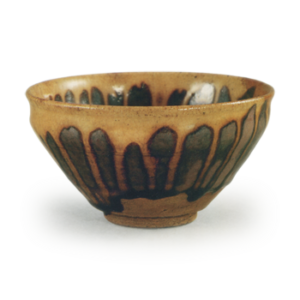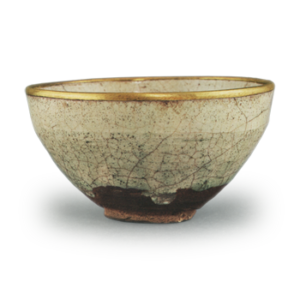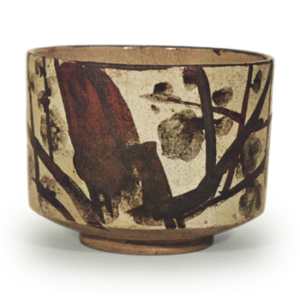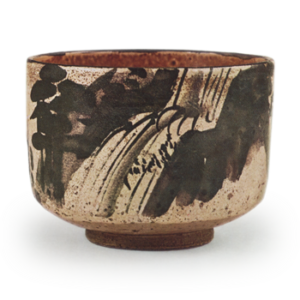
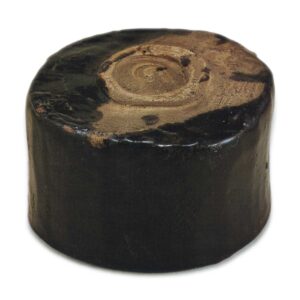
Height: 8.1-8.7cm
Diameter: 11.2-13.3cm
Outer diameter of foot ring: 5.5-5.8cm
Height: 0.3cm
The characters “Setoguro Kobara-onna” written in red on the lid of the box are said to be the work of Sen Sōtan, and if this is the case, it is thought that he named this bowl “Kobara-onna” with the “Kobara-ki” in mind, and so the tradition that Kobara-ki was owned by Rikyu is naturally plausible. If this is the case, it would mean that the strong, so-called Oribe-style tea bowls were already being made during Rikyu’s lifetime. The Obara-onna tea bowl is the largest of the Setoguro tea bowls in this volume, but if the Obaraki and Fuyu no Yoru tea bowls are considered to be rather unusual, then the shape of this tea bowl can be said to represent the typical style of the general Setoguro tea bowls that remain today. Compared to the overall size, the low, small foot ring is slightly disproportionate, and the body rises in a straight line with a straight line around the foot ring, and the mouth of the bowl, which is undulated like a mountain path, also has a straight line of grooves added to it, and all of these are common features of Setoguro, and it is also a general characteristic that the low foot of the bowl means that your fingers cannot reach the bottom.
The foot ring is probably a foot ring attached to the body, but some people think it is a foot ring carved out of the body. The foot ring is not as well-balanced as in the “Winter Night” tea bowl, but is uneven due to the addition of the stick, and the inside of the foot ring has been deliberately carved out to form a swirl.
The most outstanding features of this tea bowl are the way the body rises up and the shape of the rim, which is made to curve slightly from the waist to the rim in a straight line, and the way the body is scraped with a tool, which gives it a strong, masculine feel, and the way the rim is chamfered, which shows a certain level of skill. However, the workmanship is not as strong as that of the Kobarigi, nor is it as simple as that of the Fuyu no Yoru. Therefore, if we make a reasonable guess, we can see that the form of Setoguro has changed through the processes of Fuyu no Yoru, Kobarime and Kobarigi. The inside is also deep and large in proportion to the outside, and it is made to be spacious, with a tea-cup-shaped dent in the center. During firing, the waist seems to have sagged slightly, but this is also a common feature of Setoguro.
Along with the good shape, another feature is the beauty of the jet-black glaze, which is probably one of the best in Setoguro. As is characteristic of Setoguro, the entire interior and exterior is covered in black glaze, leaving only the triangular unglazed area at the foot of the rim, but it is a deep black color with a pleasant softness. There is also a little flying glaze on the foot of the rim and the unglazed area at the foot of the rim, and there are what appear to be scissors marks around the rim. There are three horizontal cracks at the base of the body.
Setoguro is also called hikidashi-kuro, and this type of black glaze is produced by pulling the ware out of the kiln and cooling it quickly, but it is not yet clear whether the idea for this came first from Raku ware or Setoguro. It is generally thought that Setoguro came first.
This tea bowl was passed down in the Wakasu Sakai family.

